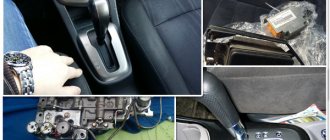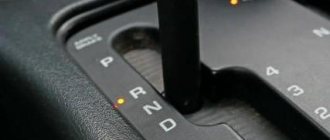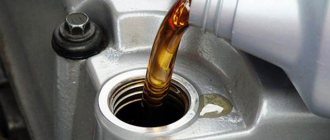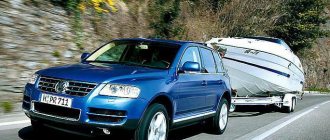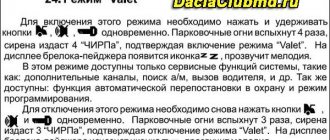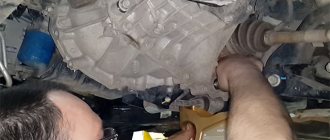History of automatic transmission development and selector evolution
The first cars with a full automatic transmission appeared in 1940 from General Motors and Cadillac. The cars were equipped with a three-speed automatic transmission with a hydraulic shift control system. This concept remained unchanged for the next 40 years. The lever for selecting the automatic transmission range in American cars has always been installed on the steering column.
The automatic transmission selector of the Soviet bus Liaz 677 had the following designations: PP, A, N, ZH. PP - forced first gear for starting on icy asphalt on all-season wheels
In the early 80s, the development of automatic transmissions went in two main directions. The first is an increase in the number of gears. In 2001, BMW began installing six-speed transmissions on its cars. The second direction is the emergence of an electronic transmission control unit. Initially, the task of electronic systems was only to determine the moment of gear shifting. Then systems appeared that made it possible to analyze driving style and select a gear shift algorithm that suited the driver.
The location of the automatic transmission lever was constantly changing during this period. The steering column arrangement has been preserved due to the ease of access to the lever and the ability to use the wide seats of the first row. Along with it, cars with a floor-mounted automatic transmission appeared. This option has gained great popularity in Europe due to the familiar location of the selector. The third option is to install the lever on the center console adjacent to the bottom of the front panel of the car. This arrangement was pioneered by Chrysler and Honda. This arrangement is especially convenient for family minivans with a high driving position. An additional advantage of installing the selector on the center console that does not reach the floor is the ability to use wide seats and move around the cabin without leaving the car (for example, in order to approach a child sitting in a child seat installed in the rear seat).
Main (large) button
Big button
Automatic VAZ
The main large key is needed to change gears. Without pressing it, you will not be able to change gears on an automatic transmission. On my AVEO, this button is made in such a way that whether you want it or not, you have to press it.
need to press
gear change
Why such buttons for fixing the automatic transmission lever are needed, everything is simple - this is done so as not to accidentally move the selector to an unnecessary position, for example, if you hit it with your hand or dropped something, and a child might pull it. And if you suddenly shift the lever into reverse gear at speed, then it’s not far from a breakdown. This is what the main big button on the automatic transmission lever is for. In principle, this is elementary and everyone knows it.
What does the automatic transmission mode selector control?
To understand what the automatic transmission operating modes are that the selector allows you to select, you need to know that an automatic transmission is not one unit, but two, combined in one housing. This is a torque converter and an automatic gearbox. A torque converter is a device for transmitting torque. It consists of two blade machines - a centrifugal pump and a turbine. The pump wheel is connected to the crankshaft, and the turbine wheel is connected to the input shaft of the gearbox. It turns out that the oil, which is used to transmit energy, moves through the blades of the pump wheel and turbine. To direct the movement of the working fluid, a mechanism called a “reactor” is used. The reactor is a wheel with blades through which ATF fluid passes, returning from the turbine to the pump. When the turbine wheel approaches the speed of rotation of the pump wheel, the reactor wheel is released and begins to rotate. In this mode, the maximum torque value for the current gear is achieved.
The world's first seven-speed automatic transmission was the "7G-Tronic" from Mercedes-Benz
Since the torque converter cannot convert rotation speed and torque over a wide range, a multi-speed gearbox is attached to it. This allows efficient use of torque in all driving conditions.
What do the buttons on the automatic transmission shift lever mean: O/D, MANU and POWER?
The “O/D” (Overdrive) button, when turned on, engages the fourth, highest gear. When the button is pressed, the automatic transmission changes to four speeds. When released (the “O/D OFF” indicator is on), three-stage. When Overdrive is turned on, the car loses a little dynamics, but fuel consumption decreases.
- When it is recommended to use O/D mode (O/D ON):
- during uniform movement at high speed (on highways, on high-speed sections)
- at speeds above 70 km/h (fuel consumption decreases, speed drops)
- many generally recommend never turning off O/D, except in cases where fast acceleration is required (for example, overtaking someone or actively driving through the city during rush hour).
- When it is NOT recommended to use O/D mode (O/D OFF):
- when driving in the city, especially on winter roads (fourth gear is eliminated, which allows more efficient use of engine braking)
- when the car is fully loaded
- if there are frequent shifts between 3rd and 4th gear (to prevent increased wear of the automatic transmission)
- when overtaking, in icy conditions, on a steep descent or in sharp turns.
MANU
The “Manu” mode is designed for use in winter, when driving on slippery surfaces, to reduce the likelihood of wheel slipping. The car starts from second gear and upshifts occur at lower engine speeds (1500-2000, 2500-3000 - the numbers vary depending on the pressure on the pedal).
The “MANU” mode “coarsens” the response of the box, the car becomes “sluggish”, engine braking is maximized, which, of course, is very useful in winter conditions. In summer, on asphalt or when overtaking, it is better to disable this mode. When “MANU” is turned on, “POWER” mode is automatically turned off.
In addition, in the “MANU” mode the selected gear is forcibly fixed and all automatic gear changes are not carried out. Fuel consumption is reduced, which is why this mode is sometimes called “economical”. In addition, different car brands may have different names for this mode. Instead of Toyota's "MANU" it may be called "SNOW" or "HOLD".
POWER
This mode is considered the opposite of the "MANU" mode, sometimes called "sport". The automatic switches to higher gears in the area of maximum engine speed, the engine develops maximum power, due to which better dynamics are achieved and the car develops greater acceleration. The POWER mode allows you to get the kick-down effect without pressing the pedal to the floor. It is clear that fuel consumption increases, and sometimes very noticeably. The “POWER” mode can also be designated as “PWR” or “SHIFT” (on Nissan machines, for example).
Red button with hieroglyphs
It is needed in order to switch the automatic transmission lever from one position to another when the engine is not running (for example, when you need to pull out the radio, but the automatic transmission lever is in the way).
Features of the floor placement of the automatic transmission lever
Flooring has seen the most changes from the 1980s to the present. Initially, the lever moved only in a straight line and carried out a standard selection of modes: forward, backward and neutral (D, R, N). Later, the movement of the selector changed - it began to move along a stepped trajectory. This innovation is connected, first of all, with the fact that when moving, the lever may accidentally move downwards, which can lead to breakage of the box, since the main modes can only be switched when stopping completely. The stepped trajectory allows you to avoid accidental movement of the lever: to select the desired mode, you need to move the lever straight and sideways, after which it locks.
Many cars with automatic transmission have a safety device that prevents the selector lever from being moved to positions D and R unless the brake pedal is depressed.
A lock from accidental switching has appeared in the form of a button on the lever. It works simply: to move you need to press the button, otherwise the lever does not move. The disadvantage of such a blocker is that it breaks quite often.
BMW has applied yet another innovation to its SUVs. Several years ago, the automatic transmission selector on BMW X5 cars became electronic. It looks like a computer joystick with additional mode switching buttons on the left and right. Parking mode is activated with a separate button.
Small button
I’ll say right away that I don’t have one, but on many cars (especially Nissan cars) they have a small key at the bottom under the big one. What is it for? Many people have been tormented by this question for a long time? Everything is also simple, this key activates the OD or Over Drive mode, I won’t focus on it now, but this is one of the operating modes of the automatic transmission and with this button you activate it. In fairness, it is worth noting that sometimes the OD button is sometimes attached to the platform near the automatic transmission lever, or is missing altogether.
Nissan button on the automatic transmission lever
Operating modes
The selector, regardless of its location, has several positions. Their number may vary on different cars, but there are several basic ones - P, R, N, D, 3, 2, 1/L.
Some cars with automatic transmission have a semi-automatic mode. The essence of this mode is that the driver selects the moment of switching, and the process of changing the gear ratio is provided by the control system. To select semi-automatic mode, the lever moves to the side and falls into a small separate channel that limits its movement. The upper position of the channel is indicated by a “plus” sign, which means an increase in gear, and the lower position, respectively, with a “minus” sign, which means a downshift.
Keys "+" and "-" on the lever
Also on the automatic transmission lever you can find the “+” and “-” buttons; they are made either with a separate “rocking” key (like I have on Chevrolet) or with two separate small keys.
“+” and “-” buttons on the automatic transmission
These buttons activate mechanical modes on the automatic transmission. By pressing “plus” you upshift, but by pressing “minus” you downshift. Some semblance of mechanics, only automatic and without a clutch.
This is such an easy article, I hope it helped you. Read our AUTO SITE.
( 7 votes, average: 5.00 out of 5)
Automatic gearbox, meaning of letters, photo
Here, for example, are ordinary photos of some types of automatic transmissions in automobile gearboxes. For many mechanical enthusiasts, these symbols do not mean anything, but only confuse them more and distance them from the automatic transmission.
Therefore, let's try to dispel the fog of doubt and ignorance by explaining the meaning of each symbol on the automatic transmission:
- R – translated in English as Parking, parking or parking. The car is switched to this mode only after a complete stop. If you are standing on a hill, it is recommended to first put the car on the handbrake and only then move the lever to the Parking position, after which you can leave the car and go about your business
- R - literally Reverse, back, back - that is, normal reverse gear, engage it when there is a need to drive in reverse
- N - translated as Neutral, that is, neutral, neutral speed, it is mainly used for towing a car, usually when standing in a traffic jam, it is recommended to hold the brake pedal without moving the car to the neutral position - since this is not a manual transmission, but nevertheless, many automatic transmission owners when parking, especially in traffic jams, move the lever to position N , because you must admit that keeping your foot on the pedal for 20-30 minutes is not at all comfortable
- D or A – you can find both of these designations Drive or Automate, which is essentially the same thing, that is, you switch to this position when you need to drive, squeeze the brake, put the speed lever in position D or A and simply press the gas pedal, smoothly releasing the brake pedal and all movement has begun, now there is no need to switch with the handle, you simply regulate the speed of your movement by pressing the gas pedal with your foot in your car
- L or B (l, 1, 1L) – some types of automatic transmissions are equipped with additional functions (Low or Bottom), which can literally be translated as slow or first gear. Typically used on ice, very steep descents or uphills, or for engine braking.
- B or simply Block often means differential locking, usually on jeeps or all-wheel drive cars, in which cases it is better to read the manual for your car model
- 2 or 2L, 3or D3, 4 or D4 – means limiting the speed switching by the gearbox, that is, set it to 2 - it means the box will not shift above the second gear no matter how hard you press on the gas, set it to mode 3 - the box will not shift above the third gear no matter what you do with the accelerator pedal, the same and 4 - shifting will not occur above the fourth speed, for example, you have 6 gears in the box, you set it to mode 4 - this means the car itself will shift from 1st to 4th gear, the car will not shift to 5th and 6th
